


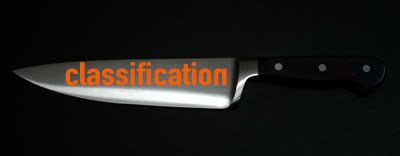
Mass murderer
Location:
Haddonfield, Illinois
Signature weapon:
Kitchen knife
Created by:
John Carpenter
Debra Hill
Portrayed by:
Nick Castle
Will Sandin (child)
Dick Warlock
George P. Wilbur
Donald L. Shanks
Chris Durand
Brad Loree
Tyler Mane
Daeg Faerch (child)
Chase Wright Vanek (child)
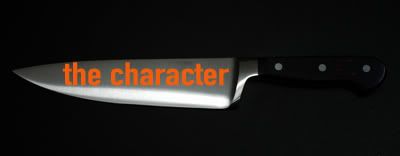
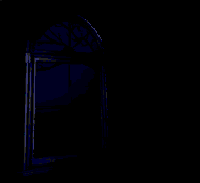
Michael Myers is a fictional character from the Halloween series of slasher films. He first appears in John Carpenter's Halloween (1978) as a young boy who murders his older sister, then fifteen years later returns home to murder more teenagers. In the original Halloween, the adult Michael Myers, referred to as The Shape in the closing credits, was portrayed by Nick Castle for most of the film, with Tony Moran and Tommy Lee Wallace substituting in during the final scenes. He was created by Debra Hill and John Carpenter. Michael Myers has appeared in eight films, as well as novels, a video game and several comic books.
The character is the primary antagonist in the Halloween film series, except Halloween III: Season of the Witch, which is not connected in continuity to the rest of the films. Since Castle, Moran, and Wallace put on the mask in the original film, six people have stepped into the role. Tyler Mane is the only actor to have portrayed Michael Myers in consecutive films, and one of only two actors to portray the character more than once. Michael Myers is characterized as pure evil, whether directly in the films, by the filmmakers who created and developed the character over eight films, or random participants in a survey.

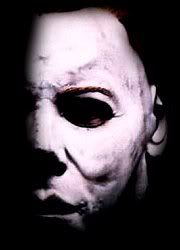
Michael Myers appears in all of the Halloween films, with the exception of Halloween III: Season of the Witch, as that film did not feature any of the characters from the original two films and had nothing to do with Michael Myers. Michael would return immediately following Halloween III, in the appropriately titled Halloween 4: The Return of Michael Myers. The silver screen is not the only place Michael Myers has appeared; there have been literary sources that have expanded the universe of Michael.
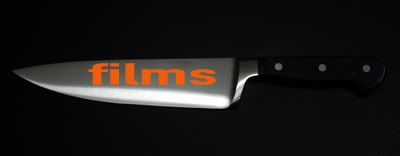
Halloween
The Night He Came Home

Michael Myers made his first appearance in the original 1978 film, Halloween, although the masked character is credited as "The Shape".
It was a cold Halloween night in 1963 when six year old Michael Audrey Myers (Will Sandin) brutally murdered his 17-year-old sister, Judith Margaret Myers (Sandy Johnson). He was sentenced to the Smith's Grove-Warren County Sanitarium for his brutal crime. There, he remained locked away and dormant for 15 years.
But on October 30, 1978, things are about to change. While being transferred for a court date, a 21-year-old Michael Myers (Nick Castle) steals a car and escapes Smith's Grove. He returns to his quiet hometown of Haddonfield, Illinois, where he follows three young women.

Seventeen-year-old Laurie Strode (Jamie Lee Curtis) is a quiet bookworm, preferring babysitting over parties. As she goes about her school day, she finds her mind playing tricks on her. Her friends, Annie and Lynda, are busy thinking about the fun of Halloween night.
That evening, Laurie and Annie are babysitting across the street from each other. Laurie has to keep an eye on comic-loving Tommy Doyle, while Annie watches "little Lindsey Wallace," obsessed with the television. Little do they know, Michael Myers has come home to kill. Carefully, he murders Annie first, followed by Lynda and her boyfriend Bob. He then sets his sights on Laurie.
Her only hope is Dr. Sam Loomis (Donald Pleasence), Michael's childhood psychiatrist who has followed Michael's trail back to Haddonfield. Loomis enlists the help of town sheriff Leigh Brackett, who happens to be Annie's father. They search the streets, but the bogeyman is close to his prize for the night: Laurie! Michael finally attacks Laurie, but she manages to fend him off long enough for Loomis to save her. Loomis shoots Michael six times in the chest, before Michael falls over the house's second-story balcony ledge; when Loomis goes to check Michael's body, he finds it missing.
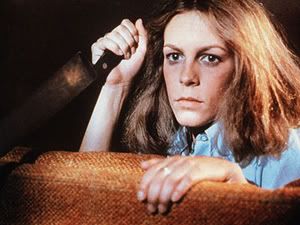 Halloween II (1981)
Halloween II (1981)
The Nightmare Isn’t Over

Michael returns in the sequel, Halloween II (1981).
Picking up right where the first HALLOWEEN left off, HALLOWEEN II continues the story of the night HE came home. The notorious Michael Myers (Dick Warlock) is still alive. Dr. Loomis, shouting "I shot him six times...I shot him in the heart..." tries to convince town sheriff Brackett that the monster is still on the loose. Meanwhile, seventeen year old Laurie Strode has been taken to Haddonfield Memorial Hospital.
After Loomis and Brackett find a trail that leads to the local elementary school, Marion Chambers (the nurse who accompanied Dr. Loomis in the first film) informs Dr. Loomis that by order of the governor, he is to return to Smith's Grove, and leave Myers for the police.
Meanwhile, Myers follows Laurie Strode to the local hospital, where he wanders the halls in search of her, killing security guards, doctors and nurses that get in his way. Killing each victim slowly, Myers makes his way through Mr. Garrett, the night watchman, Bud the ambulance driver, nurses Jill, Karen, Janet, and Mrs. Alves, and even the drunken Dr. Mixter. Laurie is left alone in the hospital with Jimmy, an orderly who has taken interest in the young woman.
Loomis learns that Laurie Strode is Michael's younger sister, and rushes to the hospital to find them. He causes an explosion in the operating theater, allowing Laurie to escape as he and Michael are engulfed by the flames.
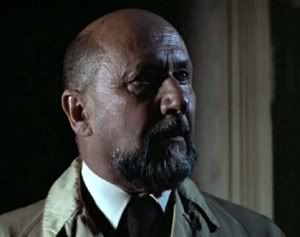 HALLOWEEN III Season of the Witch
HALLOWEEN III Season of the Witch
The Night No One Comes Home
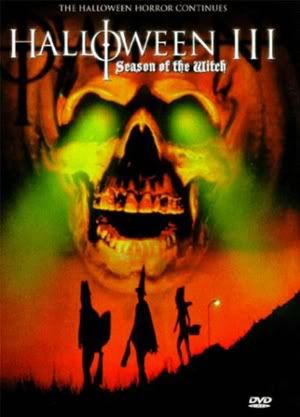
HALLOWEEN III Season of the Witch takes a break from the Michael Myers storyline and there is no reference to him or appearance by him.
Halloween 4
The Return of Michael Myers
He’s Back
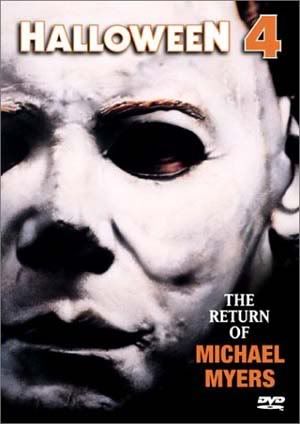
Halloween 4: The Return of Michael Myers (1988) picks the story up ten years after the events of Halloween II.
It's been a decade since Michael Myers had his last killing spree in Haddonfield. Michael (George P. Wilbur) and Dr. Loomis are revealed to have survived the explosion, although Michael has been held at Ridgemont Federal Sanitarium for a decade.
Michael wakes from his coma when he learns Laurie Strode has died, but that her daughter Jamie Lloyd (Danielle Harris) is still alive. After escaping he begins his journey back to Haddonfield.
Meanwhile, back in Haddonfield, Myers' niece Jamie Lloyd (daughter of the supposedly deceased Laurie Strode) is having nightmares about her evil uncle. Jamie’s foster, Rachel Corruthers, takes her out trick-or-treating.
Dr. Loomis tracks Michael back home, enlisting the help of Sheriff Ben Meeker. Together, they find Jamie and shelter her in Meeker's not-too-safe house. Myers makes his way in, taking his revenge on victims Kelly, Deputy Logan, and Brady. Jamie escapes to the local schoolhouse, but her fiendish uncle is hot on her trail. A high-paced finale leaves Myers buried in hell.
As everyone begins to calm down from the night, a scream is heard from the upstairs of the Corruthers' house - the evil has only started!
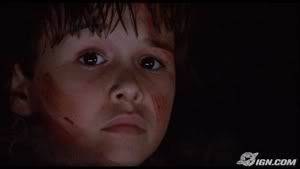 Halloween 5
Halloween 5
The Revenge of Michael Myers
Michael lives
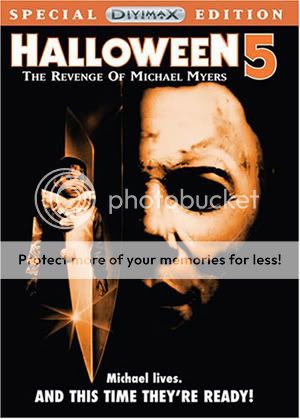
Halloween 5: The Revenge of Michael Myers (1989) begins immediately after the fourth film ends.
If you thought a mineshaft could stop The Shape at the end of the previous film, think again! Michael (Donald L. Shanks) managed to crawl out of the mine, and took refuge with a hermit who nursed him back to health. A year later, on October 31st, Michael kills the hermit and returns to Haddonfield to again find Jamie, who is still having nightmares about him.
Jamie seems to now have a telepathic bond with her evil uncle. She is able to tell Dr. Loomis when and where he will strike next. However, it's always too late...
Michael chops his way through Jamie’s beloved dog as well as her friends Tina and Sam, along with their boyfriends, some irritating cops, and a few others who get in the way.
The finale takes Dr. Loomis and Jamie to the old Myers' house, where the pair set a trap for Jamie's evil uncle. Finally, Loomis physically beats Myers to the ground. The police take Myers into custody, but a mysterious stranger, dressed in black, kills the officers and frees him giving the most mysterious HALLOWEEN ending ever!
 Halloween:
Halloween:
The Curse of Michael Myers
Terror Never Rests in Peace
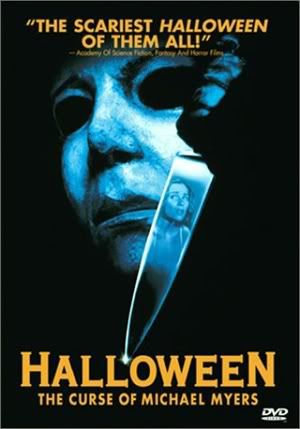
Halloween: The Curse of Michael Myers (1995) takes place six years after the events of The Revenge of Michael Myers
It's now six years since the last Halloween celebration in Haddonfield. Both Jamie (J. C. Brandy) and Michael (Wilbur) have disappeared from Haddonfield. Jamie has been kidnapped and impregnated by the Cult of Thorn. The baby arrives on Halloween eve, and a kind woman named Mary helps Jamie and her baby escape. However, Michael Myers is close behind her. HE kills Jamie, but not before she hides her newborn.
Meanwhile, Tommy Doyle (Paul Stephen Rudd) the child Laurie Strode sat for in the first film, has his eye on a family who's moved into the old Myers house. Tommy has become obsessed with Michael Myers. After hearing Jamie screaming for help on a radio show, Tommy finds her baby and hides him. While trying to protect the baby from Myers and Wynn, Tommy learns that the Curse of Thorn is the cause of Michael's obsession with killing his entire family.
The people living in the Myers' house are relatives of Laurie Strode...included is Kara Strode, and her illegitimate son, Danny - who "hears the voice" that Michael heard. Michael stalks each of the Strodes, trying to get to Jamie's baby.
The plot takes an unforseen turn when the Man in Black who was Michael’s savior in Halloween 5, reveals himself to be a major character. He is Dr. Terence Wynn (Mitch Ryan), Loomis' friend and colleague from Smith's Grove. Wynn is also the leader of the Cult of Thorn and has been manipulating Michael Myers all along. He has been experimenting with pure evil all these years...and kept it all secret at the Smith's Grove sanitarium.
Tommy and Dr. Loomis follow this madman to the sanitarium, where an all-out battle occurs with Michael. It is revealed that some form of genetic research has been happening at Smith's Grove. The film concludes with everyone getting out safe, except for Loomis, who walks back inside to "take care of unfinished business."
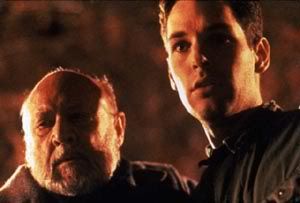 Halloween: H2O
Halloween: H2O
Blood is Thicker Than Water
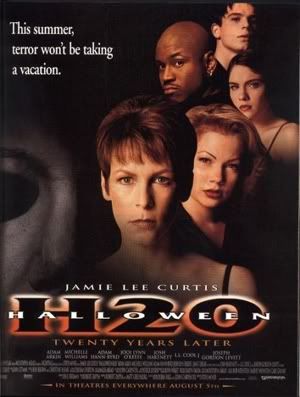
Ignoring the events of the previous three films, Halloween H20: 20 Years Later (1998) establishes that Michael Myers (Chris Durand) has been missing since 1978.
Laurie Strode (Curtis) has faked her death to escape her brother, and is now living in California under an assumed name with her teenage son John (Josh Hartnett). She is headmistress of the prestigious Hillcrest Academy.
In Illinois, Marion (Loomis' nurse from the original film) finds files related to Laurie Strode. Michael (Brad Loree) gets his hands on these files and begins making his way cross country. Myers tracks his sister to Summer Glen. There, Laurie isn't dealing with the macarbe anniversary well. She's an alcoholic who can't even be helped by her lover/school counselor Will (Adam Arkin). She knows her brother waited 15 years to come after her before. Why not another 20?
Unknown to Laurie, her son John, his girlfriend Molly, and their friends Charlie and Sarah decide to throw their own private Halloween party while the rest of the school heads off on a field trip. The only other person on campus is Ronnie, the security guard.
Michael murders John's friends as he hunts down Laurie.
As Laurie discovers that her demon from the past is back, she decides it's now or never. In a bold move, after getting her son to safety, she locks herself into the school, ready for a battle to the death between her and Michael, and succeeds in decapitating him.
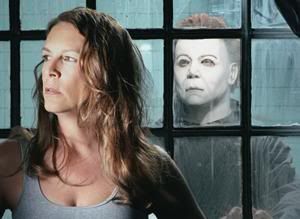 Halloween
Halloween
Resurrection
Evil Finds its Way Home

Halloween: Resurrection (2002), which picks up three years after H20, explains away Michael's death by establishing that the man Laurie decapitated was a paramedic whom Michael had attacked and swapped clothes with.
The nurses at Grace Anderson Sanitarium tell stories of patient Laurie Strode. She's the sister of the murderous legend Michael Myers - and 3 years ago, she thought she had destroyed her sibling for good.. After mistakenly killing an innocent man, she was locked away and hasn't spoken a word since.
Michael (Brad Loree) tracks down the institutionalized Laurie and kills her.
Back in the sleepy town of Haddonfield, Illinois, Freddie Harris, an ambitious entrepreneur, is ready to make some money with his new "reality" Internet event called Dangertainment. He's recruited six local college students to take part in his webcast. The "danger" arises when the students find out they have been picked to spend the night in the childhood home of Michael Myers. After an initial interview at the Haddonfield Inn, the students think they're all set for whatever scares come their way - and ready to reap the scholarship benefits Freddie is offering!
Returning to Haddonfield, Michael finds and kills the group of college students. Contestant Sara Moyer (Bianca Kajlich) and show producer Freddie Harris (Busta Rhymes) escape by trapping Myers in a burning garage.
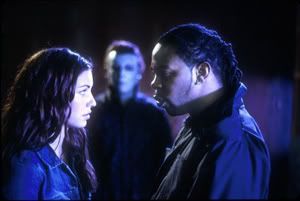 Halloween
Halloween
Evil Has A Destiny
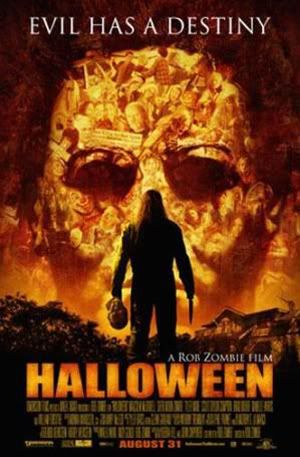
A new version of Michael Myers appears in Rob Zombie's Halloween (2007), a reimagining of the original film.
On Halloween in Haddonfield, Illinois, having already shown signs of psychopathic tendencies, ten year old Michael Myers (Daeg Faerch) murders his sister Judith (Hanna R. Hall), her boyfriend Steve (Adam Weisman), his mother’s boyfriend Ronnie (William Forsythe), and a school bully named Wesley (Daryl Sabara). After one of the longest trials in the state’s history, Michael is found guilty of first degree murder and sent to Smith's Grove - Warren County Sanitarium under the care of child psychologist Dr. Sam Loomis (Malcolm McDowell).
Michael initially cooperates with Dr. Loomis, claiming no memory of the killings; his mother, Deborah (Sheri Moon Zombie), visits him regularly. After a year, Michael becomes fixated on his papier-mâché masks, closing himself off from everyone, even his mother. When Michael kills a nurse (Sybil Danning) during one of her visits, Deborah can no longer handle the situation and commits suicide. For the next fifteen years, Michael (Tyler Mane) continues making his masks and not speaking to anyone. Dr. Loomis, having continued to treat Michael over the years, attempts to move on with his life and closes Michael’s case. Later, while being prepared for transfer to maximum security, Michael escapes Smith’s Grove, killing the sanitarium employees and a truck driver (Ken Foree) for his clothes, and heads to Haddonfield. On Halloween, Michael arrives at his old home, now abandoned, and finds a kitchen knife and Halloween mask he stored under the floorboards the night he killed his sister.
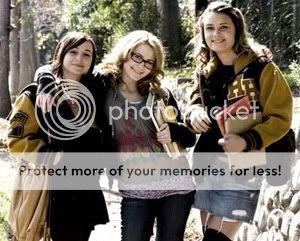
The story shifts to Laurie Strode (Scout Taylor-Compton), and her friends Annie Brackett (Danielle Harris) and Lynda Van Der Klok (Kristina Klebe) on Halloween. Throughout the day, Laurie witnesses Michael watching her from a distance. That night, she heads to the Doyle residence to watch their son Tommy (Skyler Gisondo). Meanwhile, Lynda meets with her boyfriend Bob (Nick Mennell) at Michael's childhood home. Michael appears, murders them, and then heads to the Strode home, where he murders Laurie's parents, Mason (Pat Skipper) and Cynthia (Dee Wallace). Having been alerted to Michael's escape, Dr. Loomis comes to Haddonfield looking for Michael. After obtaining a handgun, Loomis attempts to warn Sheriff Brackett (Brad Dourif) that Michael has returned to Haddonfield. Brackett and Dr. Loomis head to the Strode home, with Brackett explaining along the way that Laurie is actually Michael Myers' baby sister.
Meanwhile, Annie convinces Laurie to babysit Lindsey Wallace (Jenny Gregg Stewart), a girl Annie is supposed to be watching, long enough so she can have sex with her boyfriend Paul (Max Van Ville). Annie and Paul return to the Wallace home; during sex, Michael kills Paul and attacks Annie. Bringing Lindsey home, Laurie finds Annie on the floor, bloodied but alive, and calls 911. She is attacked by Michael, who chases her back to the Doyle home. Sheriff Brackett and Loomis hear the 911 call and head to the Wallace residence. Michael kidnaps Laurie, and takes her back to his home. Michael approaches Laurie and tries to show her that she is his younger sister. Unable to understand, Laurie grabs Michael's knife and stabs him before escaping the house; Michael chases her, but is repeatedly shot by Dr. Loomis. Laurie and Loomis are just about to leave when Michael grabs Laurie and heads back to the house. Loomis intervenes, but Michael attacks him by squeezing Loomis's skull with his hands. Laurie takes Loomis' gun and runs upstairs; she is chased by Michael, who, after cornering her on a balcony, charges her head-on and knocks both of them over the railing. Laurie finds herself on top of a bleeding Michael. Aiming Loomis' gun at his face, she repeatedly pulls the trigger until the gun finally goes off just as Michael's hand grips Laurie's wrist.
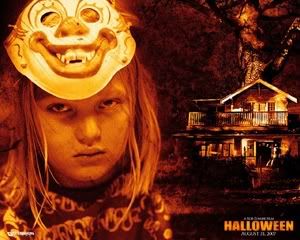 H2
H2
Family is Forever

Zombie's story is continued in the sequel, Halloween II (2009), which picks right where the remake leaves off and then jumps ahead one year. Here, Michael (Mane) is presumed dead, but resurfaces after a vision of his deceased mother Deborah (Sheri Moon Zombie) informs him that he must track Laurie (Taylor-Compton) down so that they can "come home". In the film, Michael and Laurie have a mental link, with the two sharing visions of their mother.
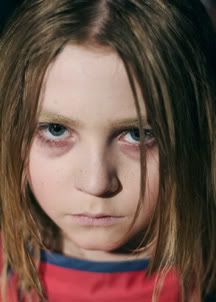
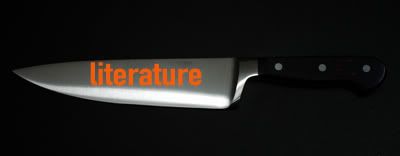
Michael Myers made his literary debut in October 1979 when Curtis Richards released a novelization of the film. The book follows the events of the film, but expands on the festival of Samhain and Michael's time at Smith's Grove Sanitarium. Michael returned to the world of literature with the 1981 adaptation of Halloween II written by Jack Martin; it was published alongside the first film sequel, with the novel following the film events, with an additional victim, a reporter, added to the novel. The final novelization to feature Michael was Halloween IV, released October 1988. The novel was written by Nicholas Grabowsky, and like the previous adaptations, follows the events of Halloween 4: The Return of Michael Myers.
Over a four month period, Berkley Books published three young adult novels written by Kelly O'Rourke; the novels are original stories created by O'Rourke, with no direct continuity with the films. The first, released on October 1, 1997, titled The Scream Factory, follows a group of friends who set up a haunted house attraction in the basement of Haddonfield City Hall, only to be stalked and killed by Michael Myers while they are there. The Old Myers Place is the second novel, released December 1, 1997, and focuses on a Mary White, who moves into the Myers house with her family. Michael returns home and begins stalking and attacking Mary and her friends. O'Rourke's final novel, The Mad House, was released on February 1, 1998. The Mad House features a young girl, Christine Ray, who joins a documentary film crew that travels to haunted locations; they are currently headed to Smith Grove Mental Hospital. The crew is quickly confronted by Michael Myers.
The character's first break into comics came with a series of comics published by Brian Pulido's Chaos Comics. The first, simply titled Halloween, was intended to be a one-issue special, but eventually two sequels spawned: Halloween II: The Blackest Eyes and Halloween III: The Devil's Eyes. All of the stories were written by Phil Nutman, with Daniel Farrands—writer for Halloween: The Curse of Michael Myers—assisting on the first issue; David Brewer and Justin Iano worked on the illustrations. Tommy Doyle is the main protagonist in each of the issues, focusing on his attempts to kill Michael Myers. The first issue includes back-story on Michael's childhood, while the third picks up after the events of the film Halloween H20.
In 2003, Michael appeared in the self-published comic One Good Scare, written by Stefan Hutchinson and illustrated by Peter Fielding. The main character in the comic is Lindsey Wallace, the young girl who first saw Michael Myers alongside Tommy Doyle in the original 1978 film. Hutchinson wanted to bring the character back to his roots, and away from the "lumbering Jason-clone" the film sequels had made him. On July 25, 2006, as an insert inside the DVD release of Halloween: 25 Years of Terror, the comic book Halloween: Autopsis was released. Written by Stefan Hutchinson, and artwork by Marcus Smith and Nick Dismas, the story is about a photographer assigned to take pictures of Michael Myers. As the photographer, Carter, follows Dr. Loomis he begins to take on Loomis's obsession himself, until finally meeting Michael Myers in person, which results in his death.
In 2008, Devil's Due Publishing began releasing more Halloween comic books, starting with a four issue mini series, titled Halloween: Nightdance. Written by Stefan Hutchinson, Nightdance takes place in Russellville, and follows Michael's obsession with Lisa Thomas, a girl who reminds him of his sister Judith. Lisa is afraid of the dark after Michael trapped her in a basement for days, and years later, he starts sending her disturbing, child-like drawings and murdering those around her on Halloween. Meanwhile, Ryan Nichols is hunting Michael down after seeing him attack and kidnap his wife. In the end, Michael frames Ryan for the murders and buries Lisa alive. Hutchinson explains that Nightdance was an attempt to escape the dense continuity of the film series and recreate the tone of the 1978 film; Michael becomes inexplicably fixated on Lisa, just as he did with Laurie in the original Halloween, before the sequels established that a sibling bond was actually his motivation for stalking her. Included in the Nightdance trade paperback is the short prose story Charlie, which features Charlie Bowles, a Russellville serial killer who taps into the same evil force which motivates Michael Myers. To celebrate the anniversary of the Halloween series, Devil's Due released a one-shot comic entitled Halloween: 30 Years of Terror in August 2008, written by Hutchinson. An anthology collection inspired by John Carpenter's original film, Michael appears in various stories, tampering with Halloween candy, decapitating a beauty queen, tormenting Laurie Strode, and killing a school teacher.
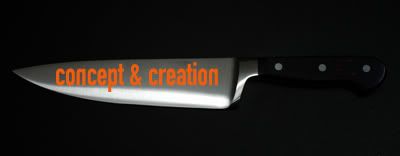
The character derives his name from distributor Michael Myers, who worked with Debra Hill and John Carpenter on Assault on Precinct 13. According to John Carpenter, Myers helped “push” ‘Assault on Precinct 13’ into the London Film Festival, that's where my reputation kind of began, so I felt I owed him. So that was my tribute to him, he was this dearest, dearest man". Carpenter wanted to “raise this Michael Myers character up to a mythic status; make him human, yes, but almost like a force. A force that will never stop, that can't be denied." He did not want to give Michael a back-story, but put him immediately into a "legendary kind of situation". To elaborate, Carpenter explained that he was influenced by Yul Brynner's "killer robot that couldn't be destroyed" in Michael Crichton's Westworld. Carpenter felt this kind of character, one that was "a force", would be more terrifying than personifying him. Michael's mask was meant to help illustrate this further, because it would "blank out his human features … Making him then just some sort of force of evil that is irrational, unstoppable."
When developing the 2007 Halloween remake, Rob Zombie commented on his intentions for the character, stating that he wanted Michael Myers to be the lead character in the film. Zombie felt the character could be made "more intense" if he was more than just a "faceless thing floating around in the background". Zombie believed it was important to be able to see the events that shape the character, making it "more disturbing" to the audience.
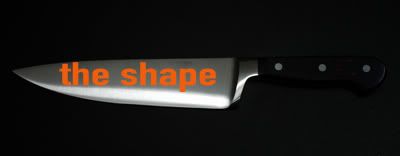
In the original film, three actors portrayed Michael Myers. Will Sandin played a six year-old Michael, who murders his sister Judith on Halloween night. Later in the film, Tony Moran and Nick Castle would portray the adult Michael, with Moran credited as "Michael Myers (age 23)" and Castle credited as "The Shape". Nick Castle was a friend, and former University of Southern California schoolmate, of John Carpenter. Production on Halloween was taking place near Castle's house, so he asked Carpenter if he could hang around the set, because he was attempting to get his own movies "off the ground". Carpenter agreed on the condition that Castle play the role of the masked killer. For his part, Castle was paid $25 a day. Debra Hill remarked:
"Nick Castle's father was a choreographer for Fred Astaire, and he just moved great. And I think John really wanted to play him as that, where he just looks, and his head turns, and he's enamored by this sister-like character that he sees in Laurie Strode. He makes the connection; he breaks out of the insane asylum and gets to his house, and sees this young girl, and makes this sort of subtle connection."
Castle's motivation while filming was simple, "walk from this point to the end point, and roll"; this was reflected in Carpenter's directing, or lack of directing, as Carpenter himself admits that the only bit of direction he gave Castle was, "Do nothing, just walk. Don't act, just walk." To elaborate, during filming Castle tried to find extra motivation for the character, attempting to get into the mind of someone who is mentally ill. Carpenter had to keep reminding him to keep it "simple"; he wanted Castle to make sure the character moved "gracefully" and was a "blank slate that we can project everything into, and make it much more horrifying". Jamie Lee Curtis believes Castle kept the character from being nothing more than just a "thug in a suit". Castle was replaced by Tony Moran for the scene where Michael is unmasked, because Carpenter and Hill wanted someone who had more of an "angelic" face.
Moran, who was looking for work, received a call from his agent about an audition for a "B flick", where he would be playing a "psycho". Moran prepared for his audition by neglecting to sleep, shave, shower or wash his hair for three days. He wore tattered clothes, with hiking boots to the audition. After being introduced to John Carpenter, Jamie Lee Curtis and Donald Pleasence, Moran proceeded to slam his feet up on the table and demand some coffee. He startled everyone at the table, and that afternoon received a phone call that he had gotten the job. Moran would take up the role from the point that Michael is strangling Laurie, as production designer Tommy Lee Wallace had performed the job during the scene where Michael breaks through the closet and Nick Castle in the part up to that scene. Moran would film the rest of the scenes—the removal of Michael's mask, being shot by Loomis and then falling over the balcony—except where Michael's body lies on the ground outside. In response to the "angelic face" remark made by Castle, Moran contends that he was not made aware of that "concept" when he was hired, but after viewing some photos of him and Carpenter on an A&E special, he "kind of sees what Castle means".
Stunt performer Dick Warlock played Michael Myers in Halloween II, replacing Castle who was beginning a career as a director. Warlock's previous experience in film was as a stunt double in films such as The Green Berets (1968), Jaws (1975) and the 1974 television series Kolchak: The Night Stalker. Warlock had not seen the original film before he was hired, but after getting the job he watched the film "two or three times", modeling his behavior after the few scenes Tommy Lee Wallace performed. Wallace portrayed the character in the scene where Michael attacks Laurie in the closet, and the scene where he sits up and turns toward Laurie, after having fallen down wounded from her counter-attack. Warlock modeled his movements for Halloween II after those scenes, as well as the scene where Michael tilts his head to the side while staring at the body of Bob stuck on the wall. Warlock took on Michael's characteristic "breathing", which was heard in the original film, while he was behind the mask. Debra Hill claims that although "the Shape" had no lines, Castle's portrayal gave them the presence that they wanted for the movie; she goes on to say that Dick Warlock was unable to emulate that presence, despite studying Castle's performance.
George P. Wilbur did not study any of the previous Halloween films when he took over the role in The Return of Michael Myers.
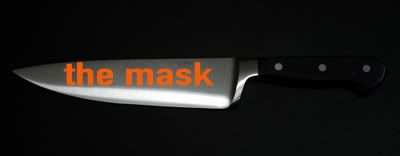

Tommy Lee Wallace, writer/director of Halloween III: Season of the Witch, was the production designer/co-editor on Halloween, and it was up to him to find "the perfect mask" for the Michael Myers character. The mask was intended to have a "blank face", and the William Shatner Halloween mask he found was exactly what he needed, "It didn't really look like anybody." Wallace cut the eyeholes larger and rounder, removed the eyebrows and sideburns, poofed up the hair so it looked "demented and strange" and finally spray-painted the mask white. Wallace explains, "It created a shiver right in the room, and we knew we had something special." John Carpenter claims that the mask looked nothing like William Shatner whatsoever, but joked, "I guess I owe the success of Halloween to William Shatner." According to Jamie Lee Curtis, the mask needed to be a "human image", and the only thing in stores at the time that matched what they needed on set was the Shatner mask. Carpenter elaborates:
"We didn't have any money to make a mask. It was originally written the way you see it, in other words, it's a pale mask with human features, almost featureless. I don't know why I wrote that down, why Debra and I decided on that, maybe it was because of an old movie called Eyes Without a Face. It's a French film, Franju made it, this girl had a burned face so she wore this face mask, it was real creepy because it was featureless and immobile except for her eyes. So Tommy Lee Wallace, our production designer, ran up to the mask shop on Hollywood Boulevard and bought a couple, one was a clown mask, and that's, you know, one way to go, and the other he got this William Shatner Star Trek mask; Captain Kirk."
Contrary to reports, the mask used in Halloween II was the mask used in the original film. According to Dick Warlock, Debra Hill stored the original mask under her bed before she brought it to Warlock to wear. Warlock offers his opinion on why the mask looks different in the second film: "I think the lighting has a lot to do with the way the mask looks from film to film. The shape of my face is also totally different than Castle's, Wallace's or probably any of the other people who wore it in Halloween." The original mask has since been sold "to a man in Ohio. He has two haunted houses. One in Toledo and one in Tiffin. He had the mask and coveralls on display there this past October. I'm supposing he'll display them every year in one place or the other," according to Warlock.
Dominique Othenin-Girard, director of Halloween 5, began casting for the Michael Myers character using the Halloween 4 mask during auditions, but was "perplexed" with Don Shanks' performance. Girard wanted the character to "feel human and alive", but knew that without dialogue or facial expressions he would not be able to achieve his goal. Girard decide to use latex material to create new masks for Don Shanks, and the KNB special effects team attempted to go for a human interpretation of evil. Girard also felt it was necessary to distance himself from the "plastic, shiny look of the hockey mask of Friday the 13th". While the special effects team worked on the new masks, Girard requested that the team alter the traditional design of the nose, which he thought felt "too realistic and too normal, too round and soft, too much like a human nose". Girard wanted "the feel of a mask", something "unmovable, like a façade hiding a terrible secret behind steel".
Adam Arkin, who plays guidance counselor Will Brennan in Halloween H20, remarks, "There's something that's so minimalistic and so neutral about that face, that becomes sort of indelibly etched in your memory, number one. And I think number two, you're able to project any kind of frightening idea or image on top of it."
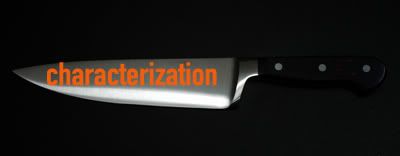
A common characterization is that Michael Myers is evil. John Carpenter has described the character as "almost a supernatural force - a force of nature. An evil force that's loose," a force that is "unkillable" Professor Nicholas Rogers elaborates, "Myers is depicted as a mythic, elusive bogeyman, one of superhuman strength who cannot be killed by bullets, stab wounds, or fire." Carpenter's inspiration for the "evil" that Michael would embody came when he was in college. While on a class trip at a mental institution in Kentucky, Carpenter visited "the most serious, mentally ill patients". Among those patients was a young boy around twelve to thirteen years-old. The boy gave this "schizophrenic stare", "a real evil stare", which Carpenter found "unsettling", "creepy", and "completely insane". Carpenter's experience would inspire the characterization Loomis would give of Michael to Sheriff Brackett in the original film. Debra Hill has stated the scene where Michael kills the Wallace's German Shepherd was done to illustrate how he is "really evil and deadly".
The ending scene of Michael being shot six times, and then disappearing from the ground outside the house, was meant to terrify the imagination of the audience. Carpenter tried to keep the audience guessing as to who Michael Myers really is—he is gone, and everywhere at the same time; he is more than human; he may be supernatural, and no one knows how he got that way. To Carpenter, keeping the audience guessing was better than explaining away the character with "he's cursed by some..." For Josh Hartnett, who portrayed John Tate in Halloween H20, "it's that abstract, it's easier for me to be afraid of it. You know, someone who just kind of appears and, you know *Mimics stabbing noise from Psycho* instead of an actual human who you think you can talk to. And no remorse, it's got no feelings… that's the most frightening, definitely." Richard Schickel, film critic for TIME, felt Michael was "irrational" and "really angry about something", having what Schickel referred to as "a kind of primitive, obsessed intelligence". Schickel considered this the "definition of a good monster", by making the character appear "less than human", but having enough intelligence "to be dangerous".
Dominique Othenin-Girard attempted to have audiences "relate to 'Evil', to Michael Myers's 'ill' side". Girard wanted Michael to appear "more human … even vulnerable, with contradicting feelings inside of him". He illustrated these feelings with a scene where Michael removes his mask and sheds a tear. Girard explains, "Again, to humanize him, to give him a tear. If Evil or in this case our boogeyman knows pain, or love or demonstrate a feeling of regrets; he becomes even more scary to me if he pursue his malefic action. He shows an evil determination beyond his feelings. Dr. Loomis tries to reach his emotional side several times in Halloween 5. He thinks he could cure Michael through his feelings."
Daniel Farrands, writer of The Curse of Michael Myers, describes the character as a "sexual deviant". According to him, the way Michael follows girls around and watches them contains a subtext of repressed sexuality. Farrands theorizes that, as a child, Michael became fixated on the murder of his sister Judith, and for his own twisted reasons felt the need to repeat that action over and over again, finding a sister-like figure in Laurie who excited him sexually. He also believes that by making Laurie, Michael's literal sister, the sequels took away from the simplicity and relatability of the original Halloween. Nevertheless, when writing Curse, Farrands was tasked with creating a mythology for Michael which defined his motives and why he couldn't be killed. He says, "He can't just be a man anymore, he's gone beyond that. He's mythical. He's supernatural. So, I took it from that standpoint that there's something else driving him. A force that goes beyond that five senses that has infected this boy's soul and now is driving him." As the script developed and more people became involved, Farrands admits that the film went too far in explaining Michael Myers and that he himself was not completely satisfied with the finished product.
Michael does not speak in the films; the first time audiences ever hear his voice is in the 2007 remake. Michael speaks as a child during the beginning of the film, but while in Smith's Grove he stops talking completely. Rob Zombie originally planned to have the adult Michael speak to Laurie in the film's finale, simply saying his childhood nickname for her, "Boo". Zombie explained that this version was not used because he was afraid having the character talk at that point would demystify him too much, and because the act of Michael handing Laurie the photograph of them together was enough.
Describing aspects of Michael Myers which he wanted to explore in the comic book Halloween: Nightdance, writer Stefan Hutchinson mentions the character's "bizarre and dark sense of humor", as seen when he wore a sheet over his head to trick a girl into thinking he was her boyfriend, and the satisfaction he gets from scaring the characters before he murders them, such as letting Laurie know he is stalking her. Hutchinson feels there is a perverse nature to Michael's actions: "see the difference between how he watches and pursues women to men". He also suggests that Michael Myers' hometown of Haddonfield is the cause of his behavior, likening his situation to that of Jack the Ripper, citing Myers as a "product of normal surburbia - all the repressed emotion of fake Norman Rockwell smiles". Hutchinson describes Michael as a "monster of abjection". When asked his opinion of Rob Zombie's expansion on Michael's family life, Hutchinson says that explaining why Michael does what he does "reduces the character". That being said, Hutchinson explores the nature of evil in the short story Charlie—included in the Halloween Nightdance trade paperback—and says that Michael Myers spent fifteen years "attuning himself to this force to the point where he is, as Loomis says, 'pure evil'".
Nightdance artist Tim Seeley describes the character's personality in John Carpenter's 1978 film as "a void", which allows the character to be more open to interpretation than the later sequels alloted him. He surmises that Michael embodies a part of everyone; a part people are afraid will one day "snap and knife someone", which lends to the fear that Michael creates on screen.
A study was conducted by California State University's Media Psychology Lab, on the psychological appeal of movie monsters—Vampires, Freddy Krueger, Frankenstein's monster, Jason Voorhees, Godzilla, Chucky, Hannibal Lecter, King Kong, and The Alien—which surveyed 1,166 people nationwide (United States), with ages ranging from 16 to 91. It was published in the Journal of Media Psychology. In the survey, Michael was considered to be the "embodiment of pure evil"; when compared to the other characters, Michael Myers was rated the highest. Michael was characterized lending to the understanding of insanity, being ranked second to Hannibal Lecter in this category; he also placed first as the character who shows audiences the "dark side of human nature". He was rated second in the category "monster enjoys killing" by the participants, and believed to have "superhuman strength". Michael was rated highest among the characters in the "monster is an outcast" category.

In Robot Chicken's nineteenth episode, "That Hurts Me", Michael Myers (voiced by Seth Green) appears as a housemate of "Horror Movie Big Brother", alongside other famous slasher movie killers such as Jason Voorhees, Freddy Krueger, Pinhead, and Leatherface. Myers is evicted from the house, and takes off his mask to reveal himself to be the comedian Mike Myers, and utters his Austin Powers catchphrase, "I feel randy, baby!" He proceeds to kill the host. Michael appeared on the April 25, 2008 episode of Ghost Whisperer, starring Jennifer Love Hewitt, titled "Horror Show". Here, a spirit communicates with Hewitt's character by placing her in scenes from the deceased's favorite horror movies, and one of the scenes involved Michael Myers. Michael Myers is set to make a cameo appearance in Rob Zombie's The Haunted World of El Superbeasto on September 22, 2009.
In the collection of short stories The Nightmares on Elm Street: Freddy Krueger's Seven Sweetest Dreams, a character, while looking through a book entitled Beasts Who Walk As Men: A Case History of America's Vilest Serial Killers, finds a page in it mentioning Michael, as well as Jason Voorhees and the Sawyer family.
In one of the various merchandises to feature the character, Michael Myers made his video game debut with the 1983 Atari video game Halloween. The game is rare to find, often being played on emulators. No characters from the films are specifically named, with the goal of the game focusing on the player, who is a babysitter, protecting children from a "homicidal maniac who has escaped from a mental institution".
Created by DarkLullaby









































